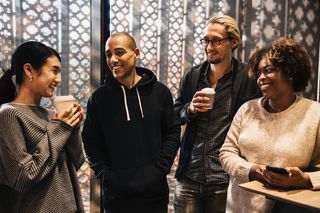Friends
What Your Friends of Color Want You to Know
Research helps shed light on cross-race friendships.
Posted September 24, 2019 Reviewed by Jessica Schrader

In 2013, Darren Agboh faced a crisis. He was finishing up his bachelor’s degree in psychology and researching how people of different races could be friends, yet he was wary of befriending anyone outside of his racial group.
He was a black man, a child of Ghanaian immigrants, and George Zimmerman was just acquitted of the charges he faced for shooting Trayvon Martin. This was a troubling time for Agboh and his white friends were not empathizing with his pain: “I just felt like they didn’t understand how black people are treated differently in this country.”
Agboh became interested in the topic of cross-racial friendship after his jarring experience of adjusting to college at a predominately white institution. He grew up in a diverse place and was surrounded by peers of all races throughout grade school. No one group was the majority, and everyone interacted freely with one another.
But once he came to college, he witnessed friendship segregation across racial lines. “The white kids hung out together, and the black kids hung out together, and I was one of the few kids who mixed with both groups.”
Now that Agboh has been studying friendship across racial lines as a social psychology Ph.D. student, he has a deeper understanding of the importance of developing cross-race friendships. According to Agboh, “the more interethnic experiences people have, the less likely they are to make generalizations about other racial groups. Avoiding people of other groups only perpetuates fears and stereotypes about those groups."
One research article that integrated findings across 515 studies found that the more contact people have with others outside of their racial group, the less prejudiced they were. I asked Agboh if he thought that this meant that people who don’t have any experience interacting with people of different racial groups harbor prejudice by default. In response, Agboh cited “social categorization theory,” a well-known and evidence-based social psychological theory that indicates that when people don’t have firsthand experience interacting with people across racial groups, they rely on generalizations and stereotypes.
I asked Agboh how he reconciles his research on inter-group friendship with his own desire to be among people of his racial group after the Trayvon Martin shooting. Agboh shared that he was likely in the “immersion stage” of racial identity. Famous models of racial identity for people of color find that people of color go through the immersion stage when they are wary of interacting with white people and seek full immersion in their racial community. This stage is triggered by experiencing or witnessing prejudice and accompanying fears of prejudice occurring. For Agboh, the Trayvon Martin shooting reminded him that he too could be a target, and he withdrew into his community to feel safe.
Agboh adds that if you’re from a group in power, you might be vulnerable to what’s called “the false consensus effect,” which is a bias in which people assume that everyone’s reality is like our own. The false consensus effect means that if a person has never experienced or observed racism, themselves, they often assume that no one experiences racism or that racism doesn’t exist: “This is probably why my white friends did not understand what I was going through; they didn’t have similar experiences with racial prejudice as I did.”
Agboh advises people from more powerful groups—men, white people, straight people—to ward off this bias by being intentional about listening, rather than dismissing or counterarguing when friends from less privileged groups share about the inequalities they experience. Recognize their sharing as an opportunity for illumination.
“Sometimes it’s hard for white people to understand that people of color need their own spaces to feel like they can be themselves, because white people aren’t wary of experiencing prejudice, like people of color are. White people may feel like—that’s not fair, I’m not prejudiced, why are you avoiding me because you’re assuming that I might be? But all of us have unconscious biases to some degree, and just because people are well-intentioned doesn’t mean that they don’t sometimes make mistakes and that those mistakes don’t cause harm.”
Agboh's words of advice for people building friendships with people of other races is to embrace a mindset of “habitual open-mindedness"—each person puts aside their pre-conceived notions when they meet someone new. It’s about allowing each person to be an individual, instead of viewing them stereotypically. One other suggestion is to try and foster a common in-group identity with people from other groups. Focus on similarities that you share with them instead of the differences that might be apparent. For example, you could focus on being from the same school or sharing the same hobbies.
Agboh also suggests avoiding using positive stereotypes to guide your interactions with people of color. When Agboh was in college, he was getting ready to go to an open mic with one of his friends, Dean, and some of Dean’s friends. He recalls being the only black person in the group. Dean and all of Dean’s friends were white. Agboh decided that he was too tired to head to the open mic, and one of Dean’s friends approached him and said “Come on! You’re black—you’re our energy for this party. Come out with us.”
“The strategy of trying to over-relate by playing off of stereotypes will backfire,” Agboh says, “because it still denies a person’s individuality, reducing them to a stereotype.”
To recap, our takeaways here for people making friends across racial lines include:
- Interacting across groups reduces prejudice.
- People of color may sometimes need to self-segregate to recover from experiences of prejudice.
- When friends of color share about racial inequities, stay open-minded and non-defensive. Recognize this as an opportunity for illumination.
- Look for similarities that you might share.
- Put stereotypes aside, be open-minded, and treat each person as an individual.
Despite his experiences, Agboh remains hopeful that we can develop friendships across racial lines. “There are more similarities about us than there are differences, and as we diversify as a country, there will only be more opportunities for us to interact with one another and form friendships. In a rapidly diversifying U.S., the only way that different groups will be able to live in harmony amongst one another is if they interact. It allows us to humanize one another.”
Note: This article is posted on my website where you can take a free quiz to assess your friendship skills.
References
Helms, J. E. (1995). An update on Helms’s White and People of Color(POC) racial identity models. In J. G. Ponterotto, J. M. Casas, L. A.Suzuki, & C. M. Alexander (Eds.), Handbook of multicultural counseling (pp. 181–198). Thousand Oaks, CA: Sage.
Pettigrew, T. & Tropp, L. (2006). A meta-analytic test of intergroup contact theory. Journal of Personality and Social Psychology, 90, 751-83. doi: 10.1037/0022-3514.90.5.751




